Energy Storage Science and Technology ›› 2025, Vol. 14 ›› Issue (3): 1026-1039.doi: 10.19799/j.cnki.2095-4239.2024.1177
• Emerging Investigator Issue of Energy Storage • Previous Articles Next Articles
Zixin XIAO( ), Hong ZHANG, Lin XU(
), Hong ZHANG, Lin XU( )
)
Received:2024-12-16
Revised:2025-02-15
Online:2025-03-28
Published:2025-04-28
Contact:
Lin XU
E-mail:1783713015@qq.com;linxu@whut.edu.cn
CLC Number:
Zixin XIAO, Hong ZHANG, Lin XU. Nanowires modulating ion transport and interfaces in solid-state lithium batteries[J]. Energy Storage Science and Technology, 2025, 14(3): 1026-1039.
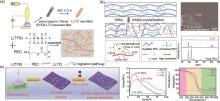
Fig. 3
(a) Schematic illustration for the preparation of composite solid electrolyte membranes and possible lithium ion migration pathways in electrolytes, (b) synthesis methods and structure of the PLN and CsPbI3 NWs, SEM images of CsPbI3 NWs, and XRD characterization of PLN, PL, and pure PEO, (c) preparation of three-dimensional fiber network reinforced polymer electrolyte (PPL) and its stress-strain and TG curves with PEO and PP"

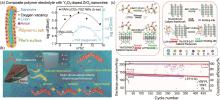
Fig. 4
(a) Schematic illustration for Li+ transport in the CSEs with Y2O3-doped ZrO2 NWs, (b) schematic diagram of the Li+ transport and lithium deposition mechanisms of HAP-PEO PSE, (c) DFT calculation models for the binding energy of Li+ to TFSI-and Cl-to the framework with the local positive charge field before and after anion exchange and cycling performance of LiFePO4||CSEs||Li solid-state batteries"

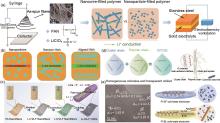
Fig. 6
(a) Schematic illustration for the synthesis of ceramic nanowire-filled CSEs, together with the comparison of ion conductive and possible lithium-ion conduction pathways in nanowire-filled and nanoparticle-filled CSEs, (b) the comparison of possible Li-ion conduction pathways. Reproduced with permission, (c) schematic illustrations of the synthetic process for the Li-HA-F nanofibers and Li-HA-F CSE with a lithium-ion conductive mechanism, (d) schematic illustration of homogeneous transparent mixtures of the cluster chain, polymer chain, and CPCSE and the organic-inorganic composite process and 1D oriented interface in CPCSE, (e) high-resolution transmission electron microscopy image of the coupled BTO-LLTO nanowires and illustration of the Li salt state in the PVDF and PVBL electrolytes"

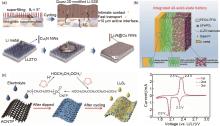
Fig. 7
(a) Schematic illustrations for molten lithium metal wettability, interfacial physical and electrochemistry of NA-LLZTO, and the process of molten Li metal being dropped on the NA-LLZTO, (b) schematic illustration of an integrated all-solid-state LiFePO4||PLLN||Li battery, (c) illustrations of the process of ACNTP in the electrolyte (The ChemDraw inset is the cationic polymerization of DOL) and typical cyclic voltammetry (CV) curves of AC/S composite electrode with the ACNTP barrier at a scan rate of 0.2 mV/s"

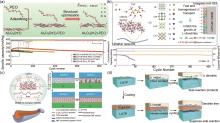
Fig. 8
(a) Schematic structure between Al2O3 (012) plane and PEO terminated chain, Cyclic performances and coulombic efficiencies for NMC811/Li batteries with different electrolytes at 0.1 mA/cm2 and 50 ℃, (b) schematic diagram of the catalytic mechanism of VCa for the reduction of LiTFSI in PLNW and long-term cycling performances of LFP||Li battery with PLNW, (c) schematic illustration of NCM811/Li solid-state batteries with PVDF and PVLN-15 electrolyte, (d) schematic illustration of effectively inhibiting interfacial side reactions and forming good interfacial contact by constructing the SE@KANF composite layer"

| 1 | GREEN M A, BREMNER S P. Energy conversion approaches and materials for high-efficiency photovoltaics[J]. Nature Materials, 2016, 16(1): 23-34. DOI:10.1038/nmat4676. |
| 2 | CHU S, CUI Y, LIU N. The path towards sustainable energy[J]. Nature Materials, 2016, 16(1): 16-22. DOI:10.1038/nmat4834. |
| 3 | BATES A M, PREGER Y, TORRES-CASTRO L, et al. Are solid-state batteries safer than lithium-ion batteries?[J]. Joule, 2022, 6(4): 742-755. DOI:10.1016/j.joule.2022.02.007. |
| 4 | YANG M, CHEN L Q, LI H, et al. Air/water stability problems and solutions for lithium batteries[J]. Energy Material Advances, 2022, 2022: 9842651. DOI:10.34133/2022/9842651. |
| 5 | CHEN Y Q, KANG Y Q, ZHAO Y, et al. A review of lithium-ion battery safety concerns: The issues, strategies, and testing standards[J]. Journal of Energy Chemistry, 2021, 59: 83-99. DOI:10.1016/j.jechem.2020.10.017. |
| 6 | XU J, XIANG S, YI C Q, et al. Green production of planar aligned dense 2D nano-oxides on CNT paper by ultrafast laser-induced high-pressure photochemistry for stable high-rate LIB anodes[J]. Energy Material Advances, 2023, 4: 12. DOI:10.34133/energymatadv. 0013. |
| 7 | WANG S, FANG R Y, LI Y T, et al. Interfacial challenges for all-solid-state batteries based on sulfide solid electrolytes[J]. Journal of Materiomics, 2021, 7(2): 209-218. DOI:10.1016/j.jmat. 2020.09.003. |
| 8 | CHEN J, WU J W, WANG X D, et al. Research progress and application prospect of solid-state electrolytes in commercial lithium-ion power batteries[J]. Energy Storage Materials, 2021, 35: 70-87. DOI:10.1016/j.ensm.2020.11.017. |
| 9 | TUFAIL M K, ZHAI P B, JIA M Y, et al. Design of solid electrolytes with fast ion transport: Computation-driven and practical approaches[J]. Energy Material Advances, 2023, 4: 15. DOI:10.34133/energymatadv.0015. |
| 10 | YAN J Q, HUANG H, TONG J F, et al. Recent progress on the modification of high nickel content NCM: Coating, doping, and single crystallization[J]. Interdisciplinary Materials, 2022, 1(3): 330-353. DOI:10.1002/idm2.12043. |
| 11 | WANG F, LIAO X B, WANG H Y, et al. Bioinspired mechanically interlocking holey graphene@SiO2 anode[J]. Interdisciplinary Materials, 2022, 1(4): 517-525. DOI:10.1002/idm2.12032. |
| 12 | HOCHBAUM A I, YANG P D. Semiconductor nanowires for energy conversion[J]. Chemical Reviews, 2010, 110(1): 527-546. DOI:10.1021/cr900075v. |
| 13 | CHEN S, YU C, WEI C C, et al. Unraveling electrochemical stability and reversible redox of Y-doped Li2ZrCl6 Solid electrolytes[J]. Energy Material Advances, 2023, 4: 19. DOI:10.34133/energymatadv.0019. |
| 14 | LIANG J W, LI X N, WANG C H, et al. Current status and future directions in environmental stability of sulfide solid-state electrolytes for all-solid-state batteries[J]. Energy Material Advances, 2023, 4: 21. DOI:10.34133/energymatadv.0021. |
| 15 | GUO R Q, ZHANG K, ZHAO W B, et al. Interfacial challenges and strategies toward practical sulfide-based solid-state lithium batteries[J]. Energy Material Advances, 2023, 4: 22. DOI:10.34133/energymatadv.0022. |
| 16 | WANG Z F, ZHANG Y S, ZHANG P H, et al. Thermally rearranged covalent organic framework with flame-retardancy as a high safety Li-ion solid electrolyte[J]. eScience, 2022, 2(3): 311-318. DOI:10.1016/j.esci.2022.03.004. |
| 17 | SUN C W, LIU J, GONG Y D, et al. Recent advances in all-solid-state rechargeable lithium batteries[J]. Nano Energy, 2017, 33: 363-386. DOI:10.1016/j.nanoen.2017.01.028. |
| 18 | WANG H P, LIU J D, HE J, et al. Pseudo-concentrated electrolytes for lithium metal batteries[J]. eScience, 2022, 2(5): 557-565. DOI:10.1016/j.esci.2022.06.005. |
| 19 | CAPUANO F, CROCE F, SCROSATI B. Composite polymer electrolytes[J]. Journal of the Electrochemical Society, 138(7): 1918-1922. DOI:10.1149/1.2085900. |
| 20 | DUAN H, YIN Y X, SHI Y, et al. Dendrite-free Li-metal battery enabled by a thin asymmetric solid electrolyte with engineered layers[J]. Journal of the American Chemical Society, 2018, 140(1): 82-85. DOI:10.1021/jacs.7b10864. |
| 21 | HUANG Y H. The discovery of cathode materials for lithium-ion batteries from the view of interdisciplinarity[J]. Interdisciplinary Materials, 2022, 1(3): 323-329. DOI:10.1002/idm2.12048. |
| 22 | WANG G X, LIANG Y H, LIU H, et al. Scalable, thin asymmetric composite solid electrolyte for high-performance all-solid-state lithium metal batteries[J]. Interdisciplinary Materials, 2022, 1(3): 434-444. DOI:10.1002/idm2.12045. |
| 23 | HU P, ZHU T, WANG X P, et al. Highly durable Na2V6O16·1.63H2O nanowire cathode for aqueous zinc-ion battery[J]. Nano Letters, 2018, 18(3): 1758-1763. DOI:10.1021/acs.nanolett.7b04889. |
| 24 | WANG X Y, WANG X Y, HUANG W G, et al. Sol-gel template synthesis of highly ordered MnO2 nanowire arrays[J]. Journal of Power Sources, 2005, 140(1): 211-215. DOI:10.1016/j.jpowsour.2004.07.033. |
| 25 | YANG M, YOU H P, LIU K, et al. Low-temperature coprecipitation synthesis and luminescent properties of LaPO4: Ln3+ (Ln3+ = Ce3+, Tb3+) nanowires and LaPO4: Ce3+, Tb3+/LaPO4 core/shell nanowires[J]. Inorganic Chemistry, 2010, 49(11): 4996-5002. DOI:10.1021/ic100099w. |
| 26 | VIVEKCHAND S R C, GUNDIAH G, GOVINDARAJ A, et al. A new method for the preparation of metal nanowires by the nebulized spray pyrolysis of precursors[J]. Advanced Materials, 2004, 16(20): 1842-1845. DOI:10.1002/adma.200400430. |
| 27 | REN W H, ZHENG Z P, LUO Y Z, et al. An electrospun hierarchical LiV3O8 nanowire-in-network for high-rate and long-life lithium batteries[J]. Journal of Materials Chemistry A, 2015, 3(39): 19850-19856. DOI:10.1039/c5ta04643b. |
| 28 | HSU P C, KONG D S, WANG S, et al. Electrolessly deposited electrospun metal nanowire transparent electrodes[J]. Journal of the American Chemical Society, 2014, 136(30): 10593-10596. DOI:10.1021/ja505741e. |
| 29 | XIAO X L, YANG L M, ZHAO H, et al. Facile synthesis of LiCoO2 nanowires with high electrochemical performance[J]. Nano Research, 2012, 5(1): 27-32. DOI:10.1007/s12274-011-0181-2. |
| 30 | FU Q G, LI H J, SHI X H, et al. Synthesis of silicon carbide nanowires by CVD without using a metallic catalyst[J]. Materials Chemistry and Physics, 2006, 100(1): 108-111. DOI:10.1016/j.matchemphys.2005.12.014. |
| 31 | XUE C S, LI H, ZHUANG H Z, et al. Synthesis of GaN nanowires with tantalum catalyst by magnetron sputtering[J]. Rare Metal Materials and Engineering, 2009, 38(7): 1129-1131. DOI:10.1016/S1875-5372(10)60041-0. |
| 32 | ZHOU G M, XU L, HU G W, et al. Nanowires for electrochemical energy storage[J]. Chemical Reviews, 2019, 119(20): 11042-11109. DOI:10.1021/acs.chemrev.9b00326. |
| 33 | MEKUYE B, ABERA B. Nanomaterials: An overview of synthesis, classification, characterization, and applications[J]. Nano Select, 2023, 4(8): 486-501. DOI:10.1002/nano.202300038. |
| 34 | TIAN B Z, ZHENG X L, KEMPA T J, et al. Coaxial silicon nanowires as solar cells and nanoelectronic power sources[J]. Nature, 2007, 449(7164): 885-889. DOI:10.1038/nature06181. |
| 35 | BAN C M, WHITTINGHAM M S. Nanoscale single-crystal vanadium oxides with layered structure by electrospinning and hydrothermal methods[J]. Solid State Ionics, 2008, 179(27/28/29/30/31/32): 1721-1724. DOI:10.1016/j.ssi.2008.01.037. |
| 36 | SHEN X, ZHANG X Q, DING F, et al. Advanced electrode materials in lithium batteries: Retrospect and prospect[J]. Energy Material Advances, 2021, 2021: 1205324. DOI:10.34133/2021/1205324. |
| 37 | MENG X B, LAU K C, ZHOU H, et al. Molecular layer deposition of crosslinked polymeric lithicone for superior lithium metal anodes[J]. Energy Material Advances, 2021, 2021: 2021/9786201. DOI:10.34133/2021/9786201. |
| 38 | DENG N P, LUO S B, ZHANG L G, et al. Synergistically enhanced roles based on 1D ceramic nanowire and 3D nanostructured polymer frameworks for composite electrolytes[J]. Journal of Energy Storage, 2024, 75: 109578. DOI:10.1016/j.est.2023.109578. |
| 39 | LIU S L, LIU W Y, BA D L, et al. Filler-integrated composite polymer electrolyte for solid-state lithium batteries[J]. Advanced Materials, 2023, 35(2): e2110423. DOI:10.1002/adma.202110423. |
| 40 | ZHAO Y C, ZHENG Y, CAI S J, et al. Li0.35La0.55TiO3 nanofibers filled poly (ethylene carbonate) composite electrolyte with enhanced ion conduction and electrochemical stability[J]. Thin Solid Films, 2021, 734: 138835. DOI:10.1016/j.tsf.2021.138835. |
| 41 | ZHANG H T, JIA A L, WANG Y C, et al. Perovskite CsPbI3 nanowire-reinforced PEO electrolytes toward high-rate all-solid-state lithium-metal battery[J]. ACS Sustainable Chemistry & Engineering, 2023, 11(41): 14986-14996. DOI:10.1021/acssuschemeng.3c03565. |
| 42 | ZHANG Z, YINGHUANG, ZHANG G Z, et al. Three-dimensional fiber network reinforced polymer electrolyte for dendrite-free all-solid-state lithium metal batteries[J]. Energy Storage Materials, 2021, 41: 631-641. DOI:10.1016/j.ensm.2021.06.030. |
| 43 | CHIANG C Y, JAIPAL REDDY M, CHU P P. Nano-tube TiO2 composite PVdF/LiPF6 solid membranes[J]. Solid State Ionics, 2004, 175(1/2/3/4): 631-635. DOI:10.1016/j.ssi.2003.12.039. |
| 44 | LIU W, LIN D C, SUN J, et al. Improved lithium ionic conductivity in composite polymer electrolytes with oxide-ion conducting nanowires[J]. ACS Nano, 2016, 10(12): 11407-11413. DOI:10.1021/acsnano.6b06797. |
| 45 | XI C P, CUI X C, ZHANG R, et al. Utilizing an oxygen-rich interface by hydroxyapatite to regulate the linear diffusion for the stable solid-state electrolytes[J]. ACS Applied Materials & Interfaces, 2022, 14(29): 33392-33399. DOI:10.1021/acsami. 2c09207. |
| 46 | LIN Y, WANG X M, LIU J, et al. Natural halloysite nano-clay electrolyte for advanced all-solid-state lithium-sulfur batteries[J]. Nano Energy, 2017, 31: 478-485. DOI:10.1016/j.nanoen. 2016.11.045. |
| 47 | LUN P Q, CHEN Z L, ZHANG Z B, et al. Enhanced ionic conductivity in halloysite nanotube-poly(vinylidene fluoride) electrolytes for solid-state lithium-ion batteries[J]. RSC Advances, 2018, 8(60): 34232-34240. DOI:10.1039/c8ra06856a. |
| 48 | HU X K, CHENG Y, DONG G Y, et al. Cation framework nanowires enabling composite solid-state electrolyte with anion exchange platform for rapid Li+ conduction[J]. Advanced Functional Materials, 2024, 34(32): 2316018. DOI:10.1002/adfm.202316018. |
| 49 | FEI F, ZHANG H, DENG J H, et al. Hydrogen bonding induced confinement effect between ultrafine nanowires and polymer chains for low-energy-barrier ion transport in composite electrolytes[J]. ACS Applied Materials & Interfaces, 2023, 15(25): 30170-30178. DOI:10.1021/acsami.3c03771. |
| 50 | DA X Y, CHEN J, QIN Y Y, et al. CO2-assisted induced self-assembled aramid nanofiber aerogel composite solid polymer electrolyte for all-solid-state lithium-metal batteries[J]. Advanced Energy Materials, 2024, 14(11): 2303527. DOI:10.1002/aenm. 202303527. |
| 51 | LIU W, LIU N, SUN J, et al. Ionic conductivity enhancement of polymer electrolytes with ceramic nanowire fillers[J]. Nano Letters, 2015, 15(4): 2740-2745. DOI:10.1021/acs.nanolett.5b00600. |
| 52 | LIU W, LEE S W, LIN D C, et al. Enhancing ionic conductivity in composite polymer electrolytes with well-aligned ceramic nanowires[J]. Nature Energy, 2017, 2(5): 17035. DOI:10.1038/nenergy.2017.35. |
| 53 | PENG J Y, LU D W, WU S Q, et al. Lithium superionic conductive nanofiber-reinforcing high-performance polymer electrolytes for solid-state batteries[J]. Journal of the American Chemical Society, 2024, 146(17): 11897-11905. DOI:10.1021/jacs.4c00882. |
| 54 | CHENG Y, LIU X W, GUO Y Q, et al. Monodispersed sub-1 nm inorganic cluster chains in polymers for solid electrolytes with enhanced Li-ion transport[J]. Advanced Materials, 2023, 35(47): e2303226. DOI:10.1002/adma.202303226. |
| 55 | SHI P R, MA J B, LIU M, et al. A dielectric electrolyte composite with high lithium-ion conductivity for high-voltage solid-state lithium metal batteries[J]. Nature Nanotechnology, 2023, 18(6): 602-610. DOI:10.1038/s41565-023-01341-2. |
| 56 | FAMPRIKIS T, CANEPA P, DAWSON J A, et al. Fundamentals of inorganic solid-state electrolytes for batteries[J]. Nature Materials, 2019, 18(12): 1278-1291. DOI:10.1038/s41563-019-0431-3. |
| 57 | ZHAO N, KHOKHAR W, BI Z J, et al. Solid garnet batteries[J]. Joule, 2019, 3(5): 1190-1199. DOI:10.1016/j.joule.2019.03.019. |
| 58 | SHEN C L, YAN M Y, LIAO X B, et al. Nanotrench superfilling facilitates embedded lithium anode for high-areal-capacity solid-state batteries[J]. ACS Nano, 2024, 18(6): 5068-5078. DOI:10.1021/acsnano.3c11724. |
| 59 | WAN Z P, LEI D N, YANG W, et al. Low resistance-integrated all-solid-state battery achieved by Li7La3Zr2O12 nanowire upgrading polyethylene oxide (PEO) composite electrolyte and PEO cathode binder[J]. Advanced Functional Materials, 2019, 29(1): 1805301. DOI:10.1002/adfm.201805301. |
| 60 | LIU Q, WANG L, HE X M. Toward practical solid-state polymer lithium batteries by in situ polymerization process: A review[J]. Advanced Energy Materials, 2023, 13(30): 2300798. DOI:10.1002/aenm.202300798. |
| 61 | XIAO G Y, XU H, BAI C, et al. Progress and perspectives of in situ polymerization method for lithium-based batteries[J]. Interdisciplinary Materials, 2023, 2(4): 609-634. DOI:10.1002/idm2.12109. |
| 62 | XU G Y, KUSHIMA A, YUAN J R, et al. Ad hoc solid electrolyte on acidized carbon nanotube paper improves cycle life of lithium-sulfur batteries[J]. Energy & Environmental Science, 2017, 10(12): 2544-2551. DOI:10.1039/c7ee01898c. |
| 63 | XU L, TANG S, CHENG Y, et al. Interfaces in solid-state lithium batteries[J]. Joule, 2018, 2(10): 1991-2015. DOI:10.1016/j.joule.2018.07.009. |
| 64 | YE Q, LIANG H Y, WANG S H, et al. Fabricating a PVDF skin for PEO-based SPE to stabilize the interface both at cathode and anode for Li-ion batteries[J]. Journal of Energy Chemistry, 2022, 70: 356-362. DOI:10.1016/j.jechem.2022.02.037. |
| 65 | SIM R, SU L S, DOLOCAN A, et al. Delineating the impact of transition-metal crossover on solid-electrolyte interphase formation with ion mass spectrometry[J]. Advanced Materials, 2024, 36(14): e2311573. DOI:10.1002/adma.202311573. |
| 66 | YANG X F, JIANG M, GAO X J, et al. Determining the limiting factor of the electrochemical stability window for PEO-based solid polymer electrolytes: Main chain or terminal-OH group?[J]. Energy & Environmental Science, 2020, 13(5): 1318-1325. DOI:10.1039/D0EE00342E. |
| 67 | LIU W C, LI G, YU W, et al. Asymmetric organic-inorganic bi-functional composite solid-state electrolyte for long stable cycling of high-voltage lithium battery[J]. Energy Storage Materials, 2023, 63: 103005. DOI:10.1016/j.ensm.2023.103005. |
| 68 | YANG L, ZHANG H, XU H T, et al. Interfacial catalysis strategy for high-performance solid-state lithium metal batteries[J]. Advanced Energy Materials,2024, 14(39), doi:10.1002/aenm. 202401829. |
| 69 | COSTA C M, CARDOSO V F, MARTINS P, et al. Smart and multifunctional materials based on electroactive poly(vinylidene fluoride): Recent advances and opportunities in sensors, actuators, energy, environmental, and biomedical applications[J]. Chemical Reviews, 2023, 123(19): 11392-11487. DOI:10.1021/acs.chemrev.3c00196. |
| 70 | LIU Q Y, YANG G J, LI X Y, et al. Polymer electrolytes based on interactions between [solvent-Li+] complex and solvent-modified polymer[J]. Energy Storage Materials, 2022, 51: 443-452. DOI:10.1016/j.ensm.2022.06.040. |
| 71 | ZHU J X, HE S, TIAN H Y, et al. The influences of DMF content in composite polymer electrolytes on Li+‐conductivity and interfacial stability with Li‐metal[J]. Advanced Functional Materials, 2023 |
| 72 | YANG K, CHEN L K, MA J B, et al. Stable interface chemistry and multiple ion transport of composite electrolyte contribute to ultra-long cycling solid-state LiNi0.8Co0.1Mn0.1O2/lithium metal batteries[J]. Angewandte Chemie (International Ed), 2021, 60(46): 24668-24675. DOI:10.1002/anie.202110917. |
| 73 | WU P F, ZHOU W W, SU X, et al. Recent advances in conduction mechanisms, synthesis methods, and improvement strategies for Li1+ xAlxTi2- x(PO4)3 solid electrolyte for all-solid-state lithium batteries[J. Advanced Energy Materials, 2022 |
| 74 | KONG W H, JIANG Z Y, LIU Y X, et al. Stabilizing Li1.3Al0.3Ti1.7(PO4)3|Li metal anode interface in solid-state batteries by Kevlar Aramid nanofiber-based protective coating[J]. Advanced Functional Materials, 2023, 33(50): 2306748. DOI:10.1002/adfm.202306748. |
| [1] | Yuhang LI, Zhuo HAN, Xufei AN, Danfeng ZHANG, Guorui ZHENG, Ming LIU, Yanbing HE. Progress of ion transport in solid-state battery research based on solid state nuclear magnetic resonance [J]. Energy Storage Science and Technology, 2024, 13(1): 178-192. |
| [2] | Qixin GAO, Jingteng ZHAO, Guoxing LI. Research progress on fast-charging lithium-ion batteries [J]. Energy Storage Science and Technology, 2023, 12(7): 2166-2184. |
| [3] | Xunchang JIANG, Minhui LIAO, Yang ZHOU, Daxiang YANG, Qiang WANG. Design and performance of nanofiber membrane-based elastic solid electrolyte [J]. Energy Storage Science and Technology, 2023, 12(11): 3307-3317. |
| [4] | Yansen ZHENG, Yongyin WANG, Jiuqing GUI, Zhuohao XIE, Yue XU, Qiaoying CAO, Yuehua XU, Yingliang LIU, Yeru LIANG. Preparation and performances of gelatin/polyethylene oxide composite electrolyte for high-voltage solid-state lithium batteries [J]. Energy Storage Science and Technology, 2023, 12(10): 3064-3074. |
| [5] | Pengbo ZHAI, Dongmei CHANG, Zhijie BI, Ning ZHAO, Xiangxin GUO. Research progress on key interfacial issues in lithium lanthanum zirconium oxide-based solid-state [J]. Energy Storage Science and Technology, 2022, 11(9): 2847-2865. |
| [6] | Jinghua WU, Jing YANG, Gaozhan LIU, Zhiyan WANG, Zhihua ZHANG, Hailong YU, Xiayin YAO, Xuejie HUANG. Review and prospective of solid-state lithium batteries in the past decade (2011—2021) [J]. Energy Storage Science and Technology, 2022, 11(9): 2713-2745. |
| [7] | ZHOU Weidong, HUANG Qiu, XIE Xiaoxin, CHEN Kejun, LI Wei, QIU Jieshan. Research progress of polymer electrolyte for solid state lithium batteries [J]. Energy Storage Science and Technology, 2022, 11(6): 1788-1805. |
| [8] | Jinping LIU, Bowei PU, Zheyi ZOU, Mingqing LI, Yuqing DING, Yuan REN, Yaqiao LUO, Jie LI, Yajie LI, Da WANG, Bing HE, Siqi SHI. Investigating thermodynamic and kinetic properties of ionic conductors via Monte Carlo simulation [J]. Energy Storage Science and Technology, 2022, 11(3): 878-896. |
| [9] | Yun TANG, Fang YUE, Kaimo GUO, Lanchun LI, Wangsong KE, Wei CHEN. Analysis of the development trend and the innovation ability of an all-solid-state lithium battery technology [J]. Energy Storage Science and Technology, 2022, 11(1): 359-369. |
| [10] | Yanming CUI, Zhihua ZHANG, Yuanqiao HUANG, Jiu LIN, Xiayin YAO, Xiaoxiong XU. Prototype all-solid-state battery electrodes preparation and assembly technology [J]. Energy Storage Science and Technology, 2021, 10(3): 836-847. |
| [11] | WU Jinghua, YAO Xiayin. Recent progress in interfaces of all-solid-state lithium batteries based on sulfide electrolytes [J]. Energy Storage Science and Technology, 2020, 9(2): 501-514. |
| [12] | ZHOU Anxing, JIANG Liwei, YUE Jinming, SUO Liumin, HU Yongsheng, LI Hong, HUANG Xuejie, CHEN Liquan. Research progress on lithium based Water-in-salt electrolytes [J]. Energy Storage Science and Technology, 2018, 7(6): 972-986. |
| [13] | XIA Qiuying, SUN Shuo, XU Jing, ZAN Feng, YUE Jili, XIA Hui. All-solid-state thin film lithium batteries [J]. Energy Storage Science and Technology, 2018, 7(4): 565-574. |
| [14] | GUO Yuguo . Project “High-energy solid-state lithium metal batteries based on nanostructured materials” [J]. Energy Storage Science and Technology, 2016, 5(6): 919-921. |
| Viewed | ||||||
|
Full text |
|
|||||
|
Abstract |
|
|||||
